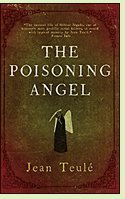The Poisoning Angel
by Jean Teulé
Reviewed by Margaret Tomlinson

The Poisoning Angel is a strangely delightful novel about a real-life murderess who in Brittany in the first half of the nineteenth century poisoned over thirty people - possibly up to twice that number - as she moved from one position as household cook to another. Hélène Jégado was born in the rural Breton village of Plouhinec, and the novel stresses the folkways and superstitions of the villagers. It opens with seven-year-old Hélène in the fields with her mother, receiving a stream of prohibitions. She is not to pick thunderflowers or viper flowers. "Don't you know that a woman picked a bunch of those and her tongue split in two?" She is not to go near a field of poppies because they "suck your blood," not to put some shiny black berries in her mouth because "belladonna berries are a deadly poison." A constant threat is the Ankou, "Death's worker," who, as Mama explains, "makes his way around Brittany with his cart and loads it up with the bodies of all those he strikes down."
Guess who is poisoned with belladonna berries before the chapter's end? It's the beginning of an almost jaunty career in murder as Hélène assumes the role of the Ankou. Her soups and cakes are exceptionally delicious, and her youthful beauty and seeming piety make her astonishingly immune to suspicion as household after household that values her cooking skills loses family member after family member to sudden, violent illness.
The Poisoning Angel consists mostly of dialogue, which gives it a stylized, almost surreal quality. Teulé makes no attempt to delve deeply into the psychology of serial murder, though he has clearly researched the subject. Instead, he uses the macabre humor of Hélène's story to make fun of the heavy load of superstitious beliefs among nineteenth-century Breton peasants, and to suggest that maybe death is not as horrible as it's cracked up to be. (2013 in the original French; English translation 2014, 228 pages)
More about The Poisoning Angel at Powell's Books or Amazon.comOther historical novels set entirely or partly in Brittany:
The Chouans by Honoré de Balzac (1829 in the original French as Les Chouans), about the 1799 royalist rebellion in Brittany and a woman's tragic love for a leader of the rebellion. More info
The Fourteenth of October by Bryher (1952), about a Saxon boy who escapes slavery in Brittany and later witnesses the Battle of Hastings. See review or more info at Amazon.com
The Conquered by Naomi Mitchison (1923), about the conflicted relationship of Roman military officer and the son of the Veneti chieftain (from the coast of what is now Brittany) who captures him, during and after Julius Caesar's Gallic War. See review or more info at Powell's Books
Nonfiction about the history of Brittany:
The Bretons by Patrick Galliou and Michael Jones (1991). More info
Brittany: A Cultural History by Wendy Mewes (2015). More info
Brittany: A Concise History by Gwenno Piette (2008). More info
Online:
The Ankou at the Mysterious Britain website
Back to Novels of Nineteenth-Century Europe
Back to Directory of Book Reviews